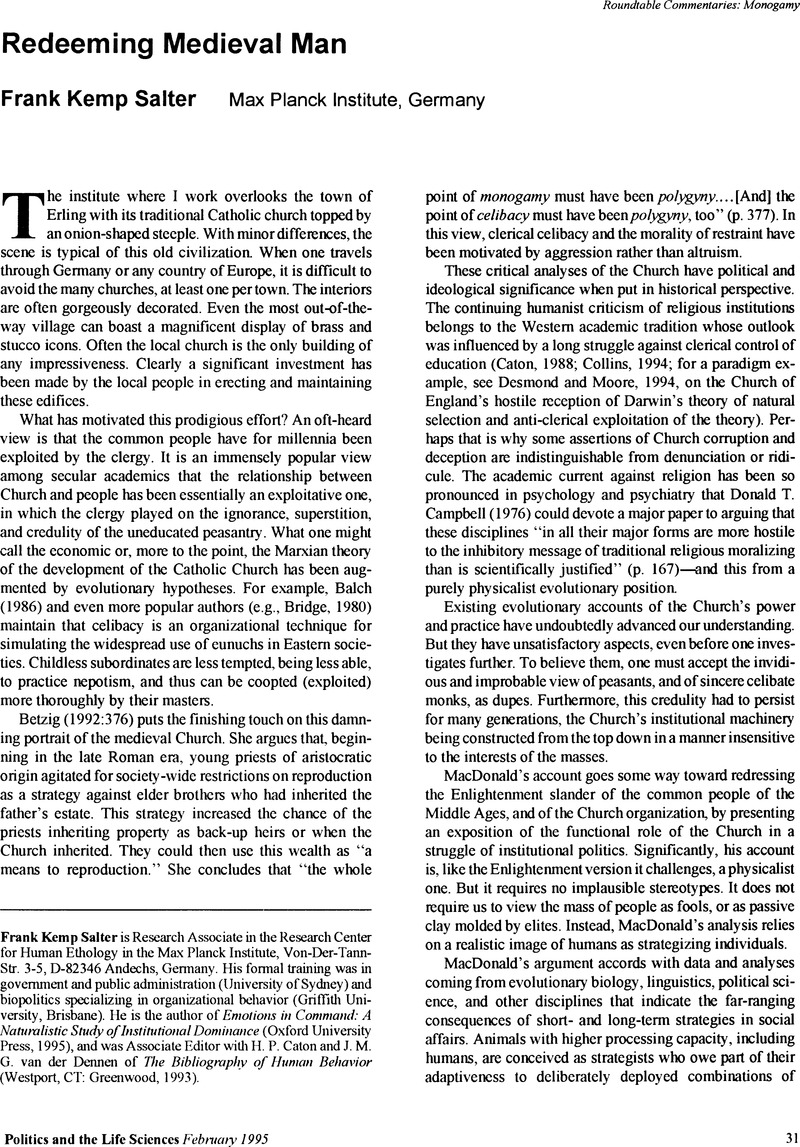No CrossRef data available.
Article contents
Redeeming Medieval Man
Published online by Cambridge University Press: 17 May 2016
Abstract
An abstract is not available for this content so a preview has been provided. Please use the Get access link above for information on how to access this content.

- Type
- Roundtable Commentaries
- Information
- Copyright
- Copyright © Association for Politics and the Life Sciences
References
Balch, S.H. (1986). “The Neutered Civil Servant': Eunuchs, Celibates, Abductees and the Maintenance of Organizational Loyalty.” In White, E. and Losco, J., (eds.), Biology And Bureaucracy: Public Administration and Public Policy from the Perspective of Evolutionary, Genetic and Neurobiological Theory. Lanham, MD: University Press of America.Google Scholar
Betzig, L.L. (1986). Despotism and Differential Reproduction: A Darwinian View of History. Chicago: Aldine.Google Scholar
Blau, P.M. and Scott, W.R. (1963). Formal Organizations: A Comparative Approach. London: Routledge and Kegan Paul. p9p5Google Scholar
Brown, P. and Levinson, S.C. (1987). Politeness: Some Universals in Language Use. Studies in Interactional Sociolinguistics 4. Cambridge: Cambridge University Press.CrossRefGoogle Scholar
Campbell, D.T. (1976). “On the Conflicts between Biological and Social Evolution and between Psychology and Moral Traditions.” Zygon: Journal of Religion and Science 11:167–208.CrossRefGoogle Scholar
Campbell, D.T. (1983). “Legal and Primary-Group Social Controls.” In Gruter, M. and Bohannan, P., (eds.), Law, Biology, and Culture. The Evolution of Law. Santa Barbara, CA.: Ross-Erikson.Google Scholar
Caton, H.P. (1988). The Politics of Progress: The Origins and Development of the Commercial Republic, 1600–1835. Gainesville: University of Florida Press.Google Scholar
Collins, R. (1994). Four Sociological Traditions. New York/Oxford: Oxford University Press.Google Scholar
Cyert, R.M. and March, J. G., eds. (1963). A Behavioral Theory of the Firm. Englewood Cliffs, NJ: Prentice-Hall.Google Scholar
Datta, S.B. (1992). “Effects of Availability of Allies on Female Dominance Structure.” In Harcourt, A.H. and de Waal, F.B.M., (eds.), Coalitions and Alliances in Humans and Other Animals. New York: Oxford University Press.Google Scholar
Durham, W.H. (1992). “Applications of Evolutionary Culture Theory.” Annual Review of Anthropology 21: 331–55.CrossRefGoogle Scholar
Eibl-Eibesfeldt, I. (1950). “Über die Jugendentwicklung des Verhaltens eines männlichen Dachses (Meles meles L.) unter besonderer Berücksichtigung des Spieles.” Zeitschrift für Tierpsychologie 7:327–55.Google Scholar
Ervin-Tripp, S. (1976). “Is Sybil There? The Structure of Some American English Directives.” Language in Society 5:25–66.CrossRefGoogle Scholar
Frank, R. (1988). Passions within Reasons: The Strategic Role of the Emotions. New York: Norton.Google Scholar
Grammer, K. (1989). “Human Courtship Behavior: Biological Basis and Cognitive Processing.” In Rasa, A. E., Vogel, C., and Voland, E., (eds.), The Sociobiology of Sexual And Reproductive Strategies. London: Chapman and Hall.Google Scholar
Hinde, R. A. (1987). Individuals, Relationships, and Culture: Links between Ethology and the Social Sciences. Cambridge: Cambridge University Press.Google Scholar
Hold-Cavell, B.C.L. and Borsutzky, D. (1986). “Strategies to Obtain High Regard: A Longitudinal Study of a Group of Preschool Children.” Ethology and Sociobiology 7:39–56.CrossRefGoogle Scholar
Lederman, R. (1986). What Gifts Engender: Social Relations And Politics in Mendi, Highland Papua New Guinea. Cambridge: Cambridge University Press.CrossRefGoogle Scholar
Masters, R.D. (1993). “Comments on Roele's ‘Religious Behavior as a Utility - and Inclusive Fitness-Optimizing Strategy”’ Social Science Information 32:418–23.Google Scholar
Mauss, M. (1968). Die Gabe. Form und Funktion des Austausches in archaischen Gesellschaften. Frankfurt/M: Surhkamp.Google Scholar
Reynolds, V. (1973). “Ethology of Social Change.” In Renfrew, C., (ed.), The Explanation of Cultural Change: Models in Prehistory. London: Duckworth.Google Scholar
Reynolds, V. and Tanner, R.E.S. (1983). The Biology of Religion. London and New York: Longman.Google Scholar
Roele, M. (1993). “Religious Behavior as a Utility- and Inclusive Fitness-Optimizing Strategy.” Social Science Information 32:387–417.Google Scholar
Salter, F.K. (1995). Emotions in Command: A Naturalistic Study of Institutional Dominance. Oxford: Oxford University Press.Google Scholar
Sargent, T. J. (1993). Bounded Rationality in Macroeconomics. Arne Ryde Memorial Lectures. Oxford: Clarendon Press.CrossRefGoogle Scholar
Tiger, L. and Fox, R. (1989/1971). The Imperial Animal. Second edition. New York: Henry Holt.Google Scholar


